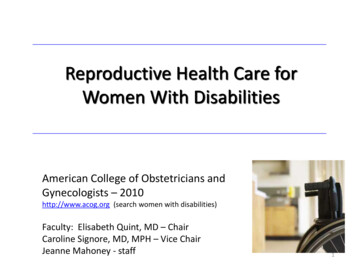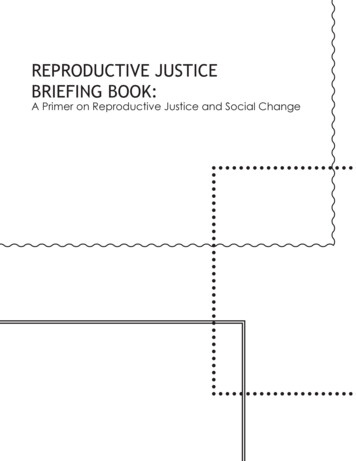
Transcription
Reproductive Health Care forWomen With DisabilitiesAmerican College of Obstetricians andGynecologists – 2010http://www.acog.org (search women with disabilities)Faculty: Elisabeth Quint, MD – ChairCaroline Signore, MD, MPH – Vice ChairJeanne Mahoney - staff1
Surgeon General’s Call to ActionTo Improve The Health And Wellness OfPersons With Disabilities - 2005Goals involve:health careproviderknowledge,personallife stylechange,accessibleservicesModule 1SCOPE OF DISABILITYEmployment and DisabilityU.S. Women Ages 21 - 64Percentpublicawareness,80706050403020100No DisabilityWith a Physical DisabilityWith a Self-care DisabilityEmployedSource: U.S. Census Bureau Supplementary Survey, 2000Employed full time forpast year9
Summary – Scope of Disability Disability does not mean sickness Disabilities are prevalent: 12% of womenage 16 to 64 identify as having a disability WWD face educational and economicbarriers WWD have unmet health needs
Module 2SEXUALITY
% AgreeingInformation About Sexuality Offered toWomen with feriddovkePrAsenomWonftIanWSource: Beckman 1989 1
Sexual Physiology Sexual response mediated by nerve rootsT10-L2 and S2-S4 Vaginal lubrication involves S2-S4 Up to 50% of women with spinal cord injury(SCI) can experience orgasm2 Most information is generalized based onmore thorough studies among men withdisabilities6
Barriers to KnowledgeWomen’s Sexual Health Research in female sexual function and dysfunction haslagged tremendously due to:– Inadequate funding of basic science research– Lack of basic science models of sexual response in femaleanimals Limited research on sexuality and WWD Professional training in sexual health remains limited7
Factors Affecting Sexual Function in WWD Physiologic or mechanical limitations Misconceptions and social stereotypes about abilityto have and enjoy sex Fear of the safety of having sexual relations Concerns about body-image, self-esteem, selfconcept Depression, stress and anxiety Fatigue Pain Life experiences (i.e. abuse)8
Strategies to Optimize Sexual Functioning inWWD General considerationsDietary issuesMedication administrationEnvironmental issuesPsychological issuesAdvocacy IssuesOther provider counseling suggestions
MedicationsAffecting Sexual FunctionAnti-hypertensivesOncologic agentsLipid-lowering depressantsStimulantsImmunosuppressive sAntispasmodicsSource: Nusbaum 20037DecongestantsAntiviralsAntiarrhythmics10
Sexuality in Adolescent Girls With andWithout DisabilitiesGirls’ Experiences at Age 16 by Physical Disability StatusPhysical DisabilityStatusNever HadSexAllConsensualBeen ForcedNo disability66.327.76.0Minimal disability48.240.910.9Mild disability63.723.412.9Severe disability57.931.011.11994-1995 Wave 1 Data from the National Longitudinal Study of Adolescent HealthProbability sample of adolescents in grades 7-12 in US Schools. N 24,105Disability severity index is set on a functional, self and parent defined scale at the time of thesurveySource: Cheng and Udry, 2002 (9)
Sexuality Considerations Adolescentswith Disabilities Need sexuality education and opendiscussion May lack knowledge /skills for safe sex Different disabilities affect puberty atdifferent rates Societal attitudes hinder sexual developmentmore than their disability Past sexual abuse likely to affect sexualexpression12
Module 3PSYCHOSOCIAL ISSUES13
Case Study - Abuse Angie, age 40 with cerebral palsy Caregiver accompanies and answerswhen questions posed to patient Poor nutritional state, unexplainedbruises and red marks on buttocksand thighs Patient fearful of abuse report
Psychosocial IssuesModule QuizTrue/False1. Most women with disabilities are depressed.2. It is important to consider the side effects of antidepressantmedications when used for WWD3. Smoking is particularly dangerous for people with mobilitydisabilities4. The prevalence of domestic abuse with WWD is equal tothat of women without disabilities.5. If the patient is non-verbal it is not possible to determine ifshe has experienced a sexual assault.6. Screening for abuse and sexual assault for WWD is similar totheir peers without disabilities.
Part 2Routine Gynecologic Health Care16
Preparation for the Appointment Schedule a longer appointment Select the most accessible exam room and havenecessary equipment available Practice with staff– Ask for patient’s preferences– Providing assistance– Safe transfer techniques Flag the chart to indicate patient requiresaccommodation17
History: what to include Reason for the visit Menstrual history:– Menstrual calendars can be very helpful– Ask about specific symptoms associated with the periods, e.g.increased seizure activity, mood changes Sexual history:– Women with disabilities are often seen as asexual. Askspecifically about sexual activity, past and present, abuse historyand need for birth control. Gynecological history Reproductive history and reproductive plans/desires Discuss past pelvic exam history and experience18
Positioning on the exam tableBe aware especiallyover thesacrumContractures19
Coding Suggestions Understanding andusing E/M service codesis essential forappropriate billing. See ACOG QuickReference on CPTCoding for Women withDisabilities (12)20
Summary –The GYN ExaminationPreparation and communication are key Prepare patient, space, staff, equipment Communicate with patient, staff Review and refine21
GYN Cancer Screening22
Attitudinal BarriersCervical Cancer ScreeningWWD are seen as asexual and not atrisk for HPV infection associated withcervical cancer.HCP uncomfortable with the disabilityand fear autonomic dysreflexia fromthe exam.23
Autonomic Dysreflexia (ADR)Occurs in women with spinal cord injury (SCI) at orabove T6Response to noxious pelvic stimulationRequires immediate attention– Stop the examinationAvoid ADR by emptying bladder and minimizingstimulation/discomfort24
Breast Cancer Screening Women over age 65 with 3 or morefunctional limitations (FLs) were less likely(28.3%) to receive a mammogram in thelast year than women with no FLs (37.9%).Chevarley, 200612 Women over age 50 with self-reportedcognitive limitation were 30% less likelythan women without cognitive limitation toutilize mammography. Legg, 20041325
Breast Cancer ScreeningWomen’s Identified BarriersDifficultygetting intoposition(34%)Source: Nosek & Howland 19974Had not beentold by aprovider toget amammogram(25%)Belief thatthey were atvery low riskfor breastcancer (24%)26
Sexually Transmitted InfectionsInformational BarriersInformational barriers: Failure to ask about sexual practices and sexual abuse Failure to screen women for sexual activity and STI’s16 Failure to educate women about safe sex practices Failure to offer information on seeking help for sexual abuse.Physical difficulty using barrier method ofcontraception 1727
Skin Inspection Should be performed daily, but this does notoften happen Positioning for pelvic examination is a criticalopportunity to assess vulnerable skinoverlying pelvic bones (ischial tuberosities andgreater trochanters)28
Grade 2 Pressure UlcerPartial-thickness skin loss involving epidermis,dermis, or both. Appears as an abrasion orblister.Source: European Pressure Ulcer Advisory Panel 20
Part IIIMedical and ReproductiveConsiderations30
Module 1Contraception31
Contraception InformationWWD often do not get appropriate contraception informationOnset of disabilityUnder age 14Over age 14% Agreeing806040200Contraception information wasSource: Beckman 198932
Contraception ConsiderationsWhen making recommendations and prescribingcontraception– Determine if method can be administered whenneeded by the woman or coordinated withhome/partner assistance– Consider side effects of contraception method– Consider effects on menses– Consider need for protection from STIs– Consider cost – insurance coverage– Consider need for legal consent (Link to Part !V- IDD)33
Progestin-only PillsAdvantages– An alternative to those who havecontraindications to estrogen containingcontraceptionDisadvantages– Irregular bleeding (link to Menses andAUB)– Must be taken at the same time daily orefficacy is affected– Some anticonvulsants decreaseeffectiveness.(Beck 1990)34
Intrauterine Device (IUD)Copper-T (10 years)May increase cramping, irregular and heavy mensesLevonorgestrel IUD (5 years)Irregular spotting in the first few months may be difficult to manageAmenorrhea may occur after 6 monthsAdvantages Long term reversible contraception (5 or 10 years)LNG-IUD decreases menses, may induce amenorrheaDoes not contain estrogenDoes not require assistance with daily or weekly administrationDisadvantages Caution for women with spinal cord injuries (Link Part 4 Module 1) Insertion may require anesthesia
Example of Slide Notes - IUDThe intrauterine device or IUD provides excellent long term, reversible contraception andcan be an good choice for many women with disabilities.There are two main types of IUDs currently being used:– The Copper-T IUD is a non-hormonal contraceptive that can remain in place for10 years. There is some risk of increased cramping and heavy menses.– The Progestin-containing Levonorgestrel IUD has the benefit of decreasedmenstrual flow to amenorrhea after the first few months of use. It may be anideal method of contraception as well as menstrual regulation for women withmenstrual flow management problems. The IUD may be used by women at risk for thromboembolism or who have otherbarriers to estrogen containing contraception and for those who have difficulty inremembering or administering daily contraception.However there are instances in which the IUD should be considered with caution. Women with a high spinal cord injury may develop Autonomic Dysreflexia (ADR) as aresult of the stimulation caused by the insertion of the IUD. If at risk for ADR,anesthesia should be consulted for the insertion. Also, an incorrectly placed IUD maynot produce the usual symptoms of pain and cramping. Patient positioning for IUD insertion may be difficult for some women withcontractures or spasms or for those women who can not cooperate with a pelvicexam. In some instances difficult insertions may require anesthesia.36
Emergency Contraception Do not forget to discuss with patients Give prescription in advance Can be used sparingly by those who can notroutinely use hormonal contraception (WHO 2004)37
Summary Contraception options should be discussed with allwomen with disabilities. Considerations involve:– The physical and pharmacological interaction of thecontraception method– The actual or potential conditions of the woman– The amount of assistance available to and required by thewoman– Her lifestyle and self-care needs– Her goals for pregnancy38
Module 2Menstrual Considerations andAbnormal Uterine Bleeding39
Impact of Menses for WWDIncreased medical concernsIncreased social concernsIncreased physical needs40
Incidence and Risk of AUBWWD have greater incidence of conditions thatmay contribute to AUB such as– Thyroid disease– Polycystic ovarian syndrome in women withepilepsy– Weight issues (Link to Part 3, Module 5)– Often take antipsychotic and some GImedications can cause high prolactin levelsThey also may report AUB more frequently dueto difficulty with menses management41
Medical Management - AUBTreatmentAdvantagesDisability ConcernNSAIDSDecreases flowNon-hormonalDecreases flowGastric distressWeeklyImmobilityPatients with IDD may pull it offContraceptive RingMonthlyProgesterone only pillDailyMay be difficult to placePatients with IDD may removeDaily remindersDMPA4 times yearlyProgesteronecontaining IUDImplants5 yearsRisk of low bone density with prolonged use.Weight gain interferes with transfersInsertion issues3 years Irregular bleeding, insertion issuesCombined oralcontraceptiveContraceptive PatchSource: ACOG Committee Opinion 2009 in printImmobility, Daily reminders
Module 3Pregnancy and Parenting43
Special Considerations for WWD andPregnancyEffect of the disability on pregnancy, laborand delivery44
Medication Considerations Anticonvulsants– Valproate – D– Carbamezepine – D– Lamotrigine – C- Phenytoin - D- Phenobarbital - D Mood Stablizer Lithium – Category D Antipsychotics Risperidone – Category C Muscle Relaxants– Baclofen – Category C– Dantrolene – Category C
Prenatal Considerations:Mobility Disability Increase in body weight and change incenter of gravity: less stable transfers andrisk of falls Changes in activity level due to fear of falling Increase in use of assistive devices Alterations in fit of prostheses Increased incidence of pressure sores46
Postpartum Considerations “Congratulations!” Not “ How can this work?” Antepartum rehabilitation nurse in-service toobstetric nurses Increased medical surveillance Potential increased length of stay Self and infant care adjustments Early involvement of pediatrician Effective family planning
Summary –Pregnancy and ParentingSteps to prevent obstetric complications– Preconceptional plan– Meticulous management of concurrent medicalconditions– Adequate nutrition and hydration– Appropriate use of prescribed and OTC medications– Care coordinationParenting considerations – Creativity is key48
Module 4Urinary and BowelConsiderations49
Management of Neurogenic Bladder Manual bladder emptyingMedication – AnticholinergicsIntermittent catheterizationIndwelling catheterSurgical procedures – Suprapubictube, ileal conduit.50
Module 5Weight, Diet andPhysical Activity51
Weight measurementWeight and weightchange can be acritical measurementin obstetrics and fordisease management52
Physical Activity for WWD Assistive devices areavailable to improvestrength and fitness Enhances overallhealth, wellness andquality of life Multiple barriers toregular exerciseSaratoga hand cycle www.randscot.com53
Module 6Adolescents with Disabilities54
Sex Education for Adolescents withDisabilitiesAssess ability toconsentAssessKnowledgeGive age anddevelopmentlevelappropriateeducation55
Considerations for Care –Separation From FamilyEncourage expression of fears and concerns56
Taking A HistoryInclude:3 C’sConfidentialContraceptionCoercionand3 S’sSexual KnowledgeSafetySubstance Abuse57
Summary - Adolescents Teens with disabilities need– Help to achieve independence– Assistance to transition from pediatrician– Attention to health risk behaviors and situations– Education and guidance on sexuality andcontraception– Special care during GYN examination– Remember the 3 C’s and 3 S’s each visit58
Module 7Aging and Osteoporosis59
Peri-Menopause Women with developmental disabilities mayhave an unusual reaction to hot flashes Menstrual hygiene issuesdue to irregular menses Increase in disability symptoms Estrogen replacement therapyhas risks associated
Part IVReproductive HealthSpecific to Disability61
Module 1 - Physical DisabilitiesSpinal cord injuryCerebral palsySpina bifidaMultiple sclerosis62
Segmental Spinal Cord Level andFunctionLevelC1-C6Neck flexorsC1-T1C3-C5Neck extensorsSupply diaphragm (mostly C4)C5-C6Shoulder movement, raise arm, flexelbow, supinates armExtends elbow and wrist, pronateswristFlexes wrist, supply small muscles ofthe handIntercostals and trunk above waistAbdominal musclesThigh, hip muscles,Hamstrings and dorsiflexion of footPlantar flexion of foot and ce: Wikipedia, 2008Function63
About Autonomic Dysreflexia Autonomic dysreflexia (ADR) is the mostimportant ob/gyn concern for women withspinal cord lesions Spinal cord lesions at or above T6 segment –50% incidence of ADR Causes severe hypertension Potentially lethal medical emergency64
Pregnancy Complications for Womenwith SCIUrinarytractinfectionsDeep terations inpulmonaryfunctionConstipation65
Medical Concerns inWomen With Spina urce: Suzawa, 200666
Spina Bifida -Pregnancy Considerations Bladder and urinary tract– Special care after urinarydiversion surgery– Increased frequency of UTI VP Shunt failure Increased risk of back pain dueto spinal abnormalities(Link -– Mod 1)67
GYN Considerations of MS Possible worsening of neurologic symptomswith menses (self-report) 40-80% of women report sexual dysfunction Fatigue commonly contributes to sexualdysfunction Depression may be associated with CNSchanges. Smoking may increase disease progression68
MS- PostpartumBreastfeeding encouraged, if no DMA isneededWatch closely for perinatal andpostpartum depressionFlare up/relapse often occurs within 3months postpartum69
CP - Reproductive Health Issues Increased spasticity and incontinence duringmenstruation reported Seizure medications may interfere withcontraception methods – (Link Part 3-Mod 1) Pain and contractures may affect sexuality Contractures and deformities may require adaptivemeasures for mammograms (link Part 2-Mod 2) and GYNexaminations. (link Part 2-Mod 1 ) Developmentally appropriate sex and contraceptioneducation70
Sub-Module 5Other Physical DisabilitiesOsteogenesis ImperfectaPost-Polio Syndrome71
Module 2Intellectual and DevelopmentalDisabilities(IDD)72
Reproductive Care Issues - IDDHistory taking and educationPhysical examinationMenstruation issuesContraception –(link to Part 3, Module 1)PregnancyInformed consentAging and osteoporosis73
Issues Seeking Health CareResistance to exams due to history of forcedexaminations causingPainAnxietyHostility74
Cyclical Behavior Changes Occurrence –16% menstruating womenwith IDD Symptoms –temper tantrums, crying,autistic or self abusive behavior, seizures Diagnosis - Documentation Therapy –– First NSAIDs (behavior may be due tocramps)– Then try OCPs, DMPA, SSRIsSource: Quint 199975
Down Syndrome - ReproductionMenstruation onset and menstrualirregularities similar to generalpopulationImpaired fertility has been notedOnly a few pregnancies have beendescribed in women with DS withvarying outcomes76
Module 6Sensory DisabilitiesHard of HearingLow Vision77
Communication Facilitators for the Deaf andHard-of-Hearing Free telephone relayservices Text messaging Discountedcommunicationsequipment Tax incentives forproviding accommodation78
Communication Suggestions for the Blindand Low Vision Don’t make assumptions about functional effects ofvisual acuity Do not touch or remove mobility aids Describe procedures before performing them All written forms and documents should be readaloud in a private setting Reading aloud may not provide effectivecommunication for some patients Use preferred techniques when handling money orcredit cards79
PART 5Access to Health Care80
United in Purpose Gaining voice Gaining politicalwill Improvingconditions
CONSUMER ATTITUDES“I’m looking forward to theday when we can justassume that doctors’ officesand the people workingthere are aware of theirresponsibilities and how totreat all people. I want tosee them know the law andrun their offices incompliance with the law.”—Marilyn Gelman HarelickReport of the Women with Disabilities Health Care Summit The New Jersey Developmental Disabilities Council ,2001 (2)82
Disability EtiquetteAddress the persondirectlyOffer to shakehandsIdentify yourself tothose who havevisual impairmentsTreat adults asadultsDo not lean on awheelchair –respect boundariesListen attentivelyto those withspeech difficultiesGain attentionfrom one who ishard of hearingbefore speakingAsk if you areunsureOffer assistance,wait foracceptance of help& instructionsPlace yourself ateye level whenconversingAdapted from: CIDNY, the Center for Independence of the Disabled in New York, Inc.(6)83
Access in the Office Exam Room84
Contents - Resources ACOG resources Federal and national resources Disability and women’s health- general information Sexuality Tobacco and substance abuse Domestic violence and sexualassault Women’s health examination Breast health Contraception Pregnancy and parentingActivity and weight controlAdolescenceAging and osteoporosisSpinal cord injuryOther physical disabilitiesDevelopmental disabilitiesBlindness and low visionDeafness and hard of hearingAdvocacy and etiquetteADA and barrier removal85
Aging and Osteoporosis Resources Association on Aging with Developmental DisabilitiesDevelops, links and supports opportunities and services for older adults with developmental disabilities.website: www.agingwithdd.orgTel: 314-647-8100 Healthy Aging – Adults with Intellectual Disabilities: Women’s Health and Related Issues. Authors:Walsh PN, Heller T Schupf N, van Schrojenstein Lantman-de Valk H. Report for the Scientific Study ofIntellectual Disabilities, World Health Org. Geneva and Univ. of WisconsinAccess at: www.who.int/mental health/media/en/20.pdf Unanticipated Lives: Aging Families of Adults with Mental Retardation: The impact of lifelong caregiving.Authors Seltzer MM, Larsonson BA, Makuch RL, Krauss MY, Robinson D. University of Wisconsin, Madisonand Brandies University, 2000 – white paper.Overview available at : atedLive.pdf Wisconsin Aging and Disabilities Resource CenterInformation for individuals, concerned families or professionals working with issues related to aging,physical disabilities, developmental disabilities, mental health issues, or substance use disorders, canreceive information specifically tailored to each person's situation.website: m
Welner Enabled (WE) continues SandraWelner, MD's legacy of advocacy for patientswith disabilities.WE designs and builds products and devicesthat enable people with disabilities andothers with special needs to access medicaldiagnosis and treatment.Website: www.welnerenabled.comTel: 800-430-981087
Thank You for participating in this program.This is a work in progress and we hope to be updating it regularly.Please contact ACOG for questions and comments:jmahoney@ACOG .orgFunded through a cooperative agreement from theCenters for Disease Control, NCBDDDTo access the recorded program directly go to o access the powerpoint program go to:http://www.acog.org/departments/dept notice.cfm?recno 38&bulletin 452688
Breast Cancer Screening Women over age 65 with 3 or more functional limitations (FLs) were less likely (28.3%) to receive a mammogram in the last year than women with no FLs (37.9%). Chevarley, 200612 Women over age 50 with self-reported cognitive limitation were 30% less likely than women without cognitive limitation to utilize mammography.










